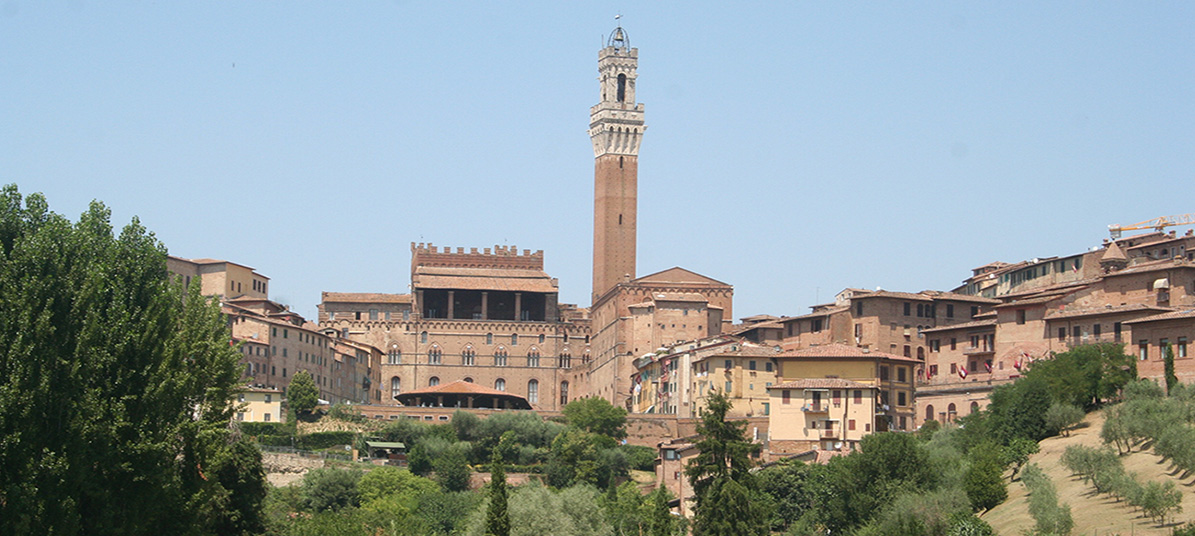| |
   |
 |
Since 1982, UNESCO (the United Nations Educational, Scientific and Cultural Organization) has added 7 places in Tuscany to the list of the World Heritage Sites Program including the Medicean Villas and Gardens just in 2013.
There are 10 selection criteria.
Tuscany is home to seven UNESCO World Heritage properties: Historic Centre of Florence (1982), Piazza del Duomo, Pisa (1987), Historic Centre of San Gimignano (1990), Historic Centre of Siena (1995), Historic Centre of the City of Pienza (1996), Val d’Orcia (2004) and Medici Villas and Gardens in Tuscany (2013).
Criteria
useful links
Official website of the UNESCO World Heritage Sites in Italy | whc.unesco.org
Traveling in Tuscany | Complete list of the UNESCO World Heritage Sites in Tuscany
|
|
travel guide for tuscany
events
exhibitions
art in tuscany
walking in tuscany
wines
films set in tuscany
gardens
the best beaches in tuscany
crete senesi
val d'orcia
market days in tuscany
|
|
| |
|
|
|
|
|
| |
|
The Unesco World Heritage Sites in Tuscany
|
|
|
|
| |
|
Historic Centre of Firenze (Florence) (1982)
|
|
|
|
| |
|
Florence is also the capital of Tuscany, and it was the first Tuscan site to be declared a UNESCO World Heritage Site. The churches and palaces of Florence hold an infinite amount of treasures of the Renaissance.
‚The Historic Centre of Florence can be perceived as a unique social and urban achievement, the result of persistent and long-lasting creativity, which includes museums, churches, buildings and artworks of immeasurable worth. Florence had an overwhelming influence on the development of architecture and the fine arts, first in Italy, and then in Europe. It is within the context of Florence that the concept of the Renaissance came to be. This heritage bestows upon Florence unique historical and aesthetic qualities. (...)
Seven hundred years of cultural and artistic blooming are tangible today in the 14th-century Cathedral of Santa Maria del Fiore, the Church of Santa Croce, the Palazzo Vecchio, the Uffizi gallery, and the Palazzo Pitti. The city’s history is further evident in the artistic works of great masters such as Giotto, Brunelleschi, Botticelli and Michelangelo.’ [2]
All of the major art historical sights are within easy walking distance in Florence.
Main sight include the Bargello Museum, Galleria dell'Accademia, Palazzo Pitti, Palazzo Vecchio, the Ponte Vecchio, Santa Croce, Santa Maria del Carmine with the Capella Brancacci, Santa Maria del Fiore (Duomo) and the Baptistery of San Giovanni, Santa Maria Novella, the Uffizi Galleryand the Vasari Corridor.
More info at Unesco’s website | Criteria: (i)(ii)(iii)(iv)(vi)
Links
Travel Guide for Tuscany | Churches, cathedrals, basilicas and monasteries of Florence
Travel Guide for Tuscany |Piazze in Firenze
Travel Guide for Tuscany | Palazzi in Florence
|
|
 |
|
| |
|
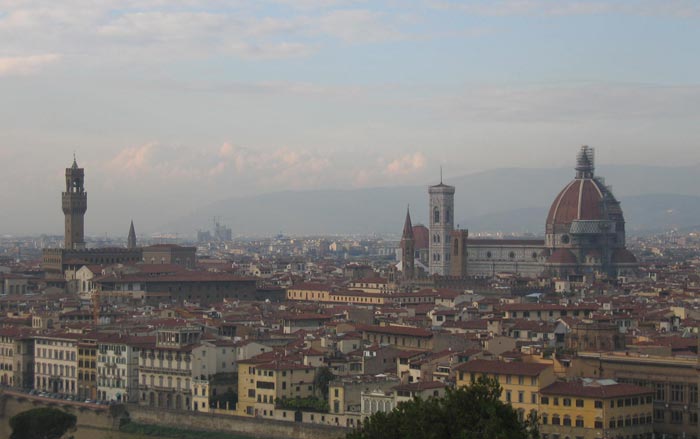 |
|
|
|
| |
|
Florence, view from Piazza Michelangelo
|
|
|
|
| |
|
Piazza del Duomo, Piazza dei Miracoli, Pisa (1987)
|
|
|
|
| |
|
|
|
|
|
| |
|
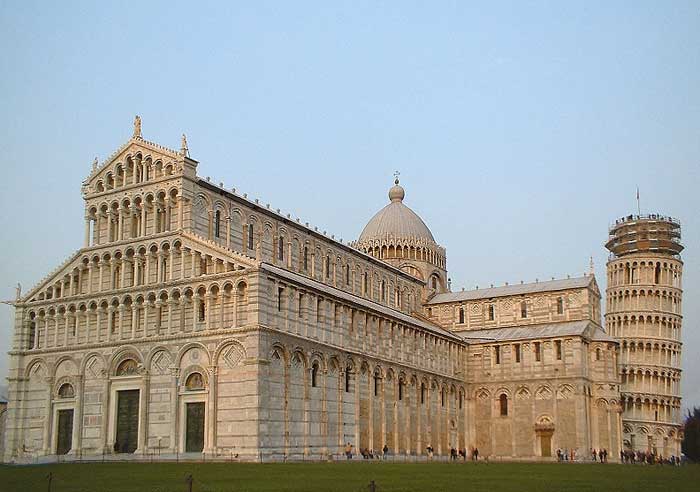 |
|
|
|
| |
|
Pisa, Piazza dei Miracoli |
|
|
|
| |
|
Historic Centre of San Gimignano and its medieval towers (1990)
|
|
|
|
| |
|
|
|
 |
|
| |
|
|
|
|
|
| |
|
|
|
|
|
| |
|
|
|
|
|
| |
|
Historic Centre of Siena (1995)
|
|
|
|
| |
|
Siena is the embodiment of a medieval city. Siena was declared a UNESCO World Heritage Site in 1995. Internationally renowned for its Palio, an ancient tradition that takes place twice a year, the whole city of Siena, built around the Piazza del Campo, was devisedas a work of art that blends into the surrounding landscape. Between the 12th and 15th centuries, the work of Duccio, the Lorenzetti brothers and Simone Martini was to influence the course of Italian and, more broadly, European art.
'The city is a masterwork of dedication and inventiveness in which the buildings have been designed to fit into the overall planned urban fabric and also to form a whole with the surrounding cultural landscape.
Criterion (i): Through its urban and architectural characteristics, the historic centre of Siena is a testimony to human creativity and expresses human artistic and aesthetic capacity in material form.
Criterion (ii): The strong, personal example of artistic civilization, its architecture, painting, sculpture and town planning in particular had a very strong cultural influence not merely on the whole territory of the Republic of Siena but also in Italy and Europe, especially between the 13th and 17th centuries.
Criterion (iv): The structure of the town and its evolution, uninterrupted over the centuries, along with a unity of design that has been preserved, has made Siena one of the most precious examples of the medieval and Renaissance Italian town." [4]
Siena | The Palazzo Pubblico and the Torre del Mangia
Siena's Palazzo Pubblico is considered one of the finest examples of gothic secular architecture.
To the left of the Palazzo Pubblico rises the imposing Torre del Mangia, which to this day remains an arrestingly beautiful combination of height and elegant slightness of design. The curious name of the tower derives from its first bell ringer, Giovanni di Duccio, who was nicknamed Mangiaguadagni and who was commissioned to ring the hours in 1347. The top of the tower, which is 88 metres high and can be reached by mounting exactly 400 steps, commands magnificent views over the city and the surrounding countryside.[5]
Siena | The Duomo
More info at Unesco’s website | Criteria: (i)(ii)(iv)
|
|

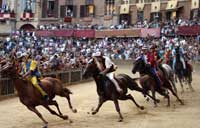
|
|
| |
|
|
|
|
|
| |
|
|
|
|
|
| |
|
Historic Centre of Pienza (1996), the Ideal City for Man
|
|
|
|
| |
|
|
|
 |
|
| |
|
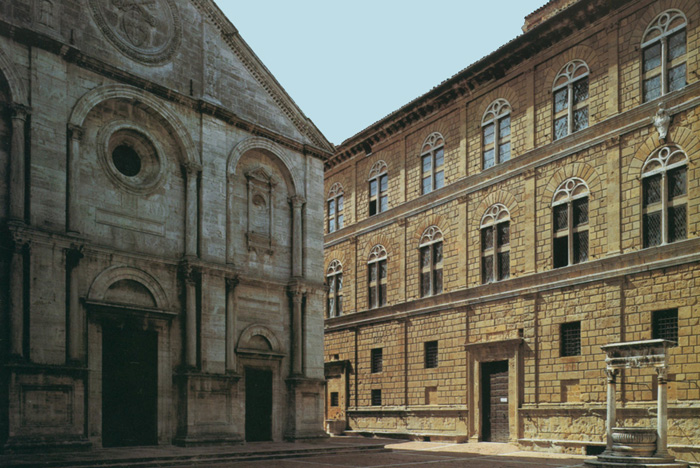 |
|
|
|
| |
|
|
|
|
|
| |
|
Val d'Orcia (2004)
|
|
|
|
| |
|
The magnificent landscape of the Val d'Orcia, part of the agricultural hinterland of Siena, has been included in the Unesco World Heritage List in 2004. According to Unesco this valley is an outstanding example of how the natural environment has been redesigned in the Renaissance and reflects the ideals of "good governance" (14th and 15th century) typical of the Italian city-States, whose splendid places were celebrated by painters of the Sienese school, which flourished between the 13th and 15th centuries.
A perfect example that depicts people living in harmony with nature, is the cycle of frescoes by Ambrogio Lorenzetti's Allegory and effects of good and bad government (1338-1339), preserved in the Palazzo Pubblico in Siena.
The Val d'Orcia is the quintessential landscape of Tuscany. But the richness and variety of the landscape are not the only elements that characterize this pristine land. The Val d’Orcia is also known for the beauty of its towns and villages such as Montalcino, Montepulciano and Pienza, perched on a hilltop and known both for their association with the arts and for their famous wines. Other little towns that deserve a visit are Castiglione d’Orcia, Radicofani, San Quirico d’Orcia, Monticchiello, Rocca d’Orcia, and San Giovanni D’Asso, the natural brigde between Crete Senesi and Val d’Orcia. The Abbazia di Sant’Antimo, a former Benedictine monastery in the comune of Montalcino, is a wonderful sight and one of the most beautiful Romanesque churches in Italy. Hot springs fans will adore the springs of Bagno Vignoni, Bagni San Filippo and Vivo d’Orcia.
Criterion (iv): The Val d’Orcia is an exceptional reflection of the way the landscape was re-written in Renaissance times to reflect the ideals of good governance and to create an aesthetically pleasing pictures.
Criterion (vi): The landscape of the Val d’Orcia was celebrated by painters from the Siennese School, which flourished during the Renaissance. Images of the Val d’Orcia, and particularly depictions of landscapes where people are depicted as living in harmony with nature, have come to be seen as icons of the Renaissance and have profoundly influenced the development of landscape thinking.’[3]
More info at Unesco’s website | Criteria: (iv)(vi)
Links
Val d'Orcia Map | Walking in Val d'Orcia
|
|

Val d'Orcia |
|
| |
|
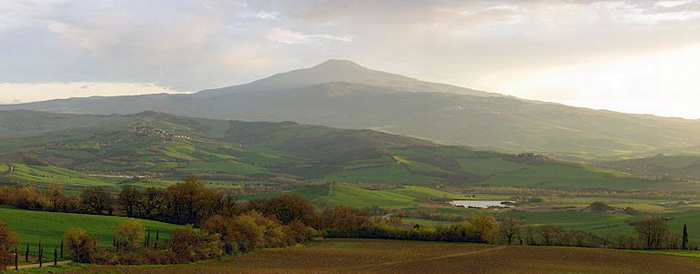 |
|
|
|
| |
|
Val d'Orcia and Monbta Amiata |
|
|
|
| |
|
The Medici Villas and Gardens (2013)
|
|
|
|
| |
|
On June 2013, twelve Medici villas and two pleasure gardens (Boboli Gardens and Pratolino Park-Villa Demidoff) were granted World Heritage status by UNESCO. These were Renaissance-era summer residences and hunting lodges for the powerful Medici family, most of which can be visited for free and which house important works from Renaissance artists.
'The villas embody an innovative form and function, a new type of princely residence that differed from both the farms owned by rich Florentines of the period and from the military might of baronial castles. The Medici villas form the first example of the connection between architecture, gardens, and the environment and became an enduring reference for princely residences throughout Italy and Europe. Their gardens and integration into the natural environment helped develop the appreciation of landscape characteristic Humanism and the Renaissance.' http://whc.unesco.org/en/list/175
The twelve Medici villas and two pleasure gardens are Villa di Cafaggiolo, Villa del Trebbio, Villa di Careggi, Villa Medici di Fiesole, Villa di Castello, Villa di Poggio a Caiano, Villa di La Petraia, Villa di Cerreto Guidi, Palazzo di Saravezza, Villa La Magia, Villa di Artimino, Villa di Poggio Imperiale, Boboli Gardens and Pratolino Park.
More info at Unesco’s website | Criteria: (ii)(iv)(vi)
Links
Gardens in Tuscany | Medici Villas in Tuscany
Ville e Giardini medicei (in Italian)
|
|
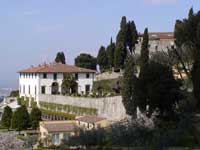 |
|
| |
|
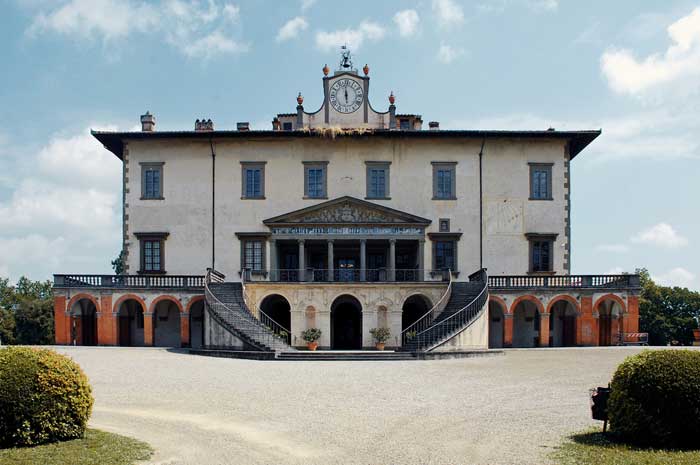 |
|
|
|
| |
|
Villa Medicea at Poggio a Caiano
|
|
|
|
| |
|
|
|
|
|
| |
|
|
|
|
|
| |
|
|
|
|
|
| |
|

|
|
|
|
| |
|
[1] These criteria are explained in the Operational Guidelines for the Implementation of the World Heritage Convention which, besides the text of the Convention, is the main working tool on World Heritage.
Selection criteria
(i)
to represent a masterpiece of human creative genius;
(ii)
to exhibit an important interchange of human values, over a span of time or within a cultural area of the world, on developments in architecture or technology, monumental arts, town-planning or landscape design;
(iii)
to bear a unique or at least exceptional testimony to a cultural tradition or to a civilization which is living or which has disappeared;
(iv)
to be an outstanding example of a type of building, architectural or technological ensemble or landscape which illustrates (a) significant stage(s) in human history;
(v)
to be an outstanding example of a traditional human settlement, land-use, or sea-use which is representative of a culture (or cultures), or human interaction with the environment especially when it has become vulnerable under the impact of irreversible change;
(vi)
to be directly or tangibly associated with events or living traditions, with ideas, or with beliefs, with artistic and literary works of outstanding universal significance. (The Committee considers that this criterion should preferably be used in conjunction with other criteria);
(vii)
to contain superlative natural phenomena or areas of exceptional natural beauty and aesthetic importance;
(viii)
to be outstanding examples representing major stages of earth's history, including the record of life, significant on-going geological processes in the development of landforms, or significant geomorphic or physiographic features;
(ix)
to be outstanding examples representing significant on-going ecological and biological processes in the evolution and development of terrestrial, fresh water, coastal and marine ecosystems and communities of plants and animals;
(x)
to contain the most important and significant natural habitats for in-situ conservation of biological diversity, including those containing threatened species of outstanding universal value from the point of view of science or conservation.
[2] Source: whc.unesco.org
[3] Source: whc.unesco.org
[4] Source: whc.unesco.org
[5] Source: The Palazzo Pubblico and the Torre del Mangia | by Siena OnLine | www.sienaonline.com |
|
|
|
| |
|
|
|
|
|
| |
|
|
|
|
|
| |
|
Complete list of the UNESCO World Heritage Sites in Italy |
|
|
|
| |
|
|
|
|
|
| |
|
Properties inscribed on the World Heritage List (51)
Cultural (47)
- 18th-Century Royal Palace at Caserta with the Park, the Aqueduct of Vanvitelli, and the San Leucio Complex (1997)
- Sacri Monti of Piedmont and Lombardy (2003)
- Arab-Norman Palermo and the Cathedral Churches of Cefalú and Monreale (2015)
- Archaeological Area and the Patriarchal Basilica of Aquileia (1998)
- Archaeological Area of Agrigento (1997)
- Archaeological Areas of Pompei, Herculaneum and Torre Annunziata (1997)
- Assisi, the Basilica of San Francesco and Other Franciscan Sites (2000)
- Botanical Garden (Orto Botanico), Padua (1997)
- Castel del Monte (1996)
- Cathedral, Torre Civica and Piazza Grande, Modena (1997)
- Church and Dominican Convent of Santa Maria delle Grazie with “The Last Supper” by Leonardo da Vinci (1980)
- Cilento and Vallo di Diano National Park with the Archeological Sites of Paestum and Velia, and the Certosa di Padula (1998)
- City of Verona (2000)
- City of Vicenza and the Palladian Villas of the Veneto (1994)
- Costiera Amalfitana (1997)
- Crespi d'Adda (1995)
- Early Christian Monuments of Ravenna (1996)
- Etruscan Necropolises of Cerveteri and Tarquinia (2004)
- Ferrara, City of the Renaissance, and its Po Delta (1995)
- Genoa: Le Strade Nuove and the system of the Palazzi dei Rolli (2006)
- Historic Centre of Florence (1982)
- Historic Centre of Naples (1995)
- Historic Centre of Rome, the Properties of the Holy See in that City Enjoying Extraterritorial Rights and San Paolo Fuori le Mura (1980)
- Historic Centre of San Gimignano (1990)
- Historic Centre of Siena (1995)
- Historic Centre of the City of Pienza (1996)
- Historic Centre of Urbino (1998)
- Late Baroque Towns of the Val di Noto (South-Eastern Sicily) (2002)
- Longobards in Italy. Places of the Power (568-774 A.D.) (2011)
- Mantua and Sabbioneta (2008)
- Medici Villas and Gardens in Tuscany (2013)
- Piazza del Duomo, Pisa (1987)
- Portovenere, Cinque Terre, and the Islands (Palmaria, Tino and Tinetto) (1997)
- Prehistoric Pile dwellings around the Alps (2011)
- Residences of the Royal House of Savoy (1997)
- Rhaetian Railway in the Albula / Bernina Landscapes (2008)
- Rock Drawings in Valcamonica (1979)
- Su Nuraxi di Barumini (1997)
- Syracuse and the Rocky Necropolis of Pantalica (2005)
- The Trulli of Alberobello (1996)
- The Sassi and the Park of the Rupestrian Churches of Matera (1993)
- Val d'Orcia (2004)
- Venice and its Lagoon (1987)
- Villa Adriana (Tivoli) (1999)
- Villa d'Este, Tivoli (2001)
- Villa Romana del Casale (1997)
- Vineyard Landscape of Piedmont: Langhe-Roero and Monferrato (2014)
Natural (4)
|
|
|
|
| |
|
|
 |
 |
|
|
